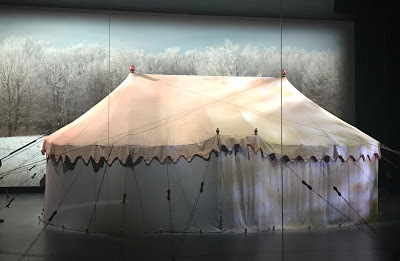When an 18thc Tent Becomes a National Relic

Susan reporting,
The new Museum of the American Revolution is filled with fascinating artifacts from the past, objects that tell stories, represent people, explain ideas, or are examples of exquisite craftsmanship. (See my earlier posts here and here .) But among all these treasures, there's only one that's a true relic on a national scale: George Washington's Headquarters Tent.
Quite simply, it's the real deal. From 1778 until 1783, this large (it's about twenty-three feet long) tent served as home and office to the commander-in-chief. While various houses were employed as headquarters during the war's many campaigns, Washington believed in sharing the same hardships as his troops. To be sure, the general's tent was more substantial than that sheltering the average soldier. His tent was supported and shaped by numerous poles and lines, and contained three small chambers: a central office, a half-circle sleeping chamber, and another small area for his luggage, with sleeping quarters for his enslaved African American valet, William Lee. But the canvas walls were the same, as was the damp or frozen ground beneath his feet. If the men were sleeping in tents through downpours, bitter frosts, and blistering heat, then the General did, too, and they respected him all the more for it.
Washington met with his generals and staff inside this tent, and major decisions about the war and the country's future were settled within it. Here Washington would also have experienced his most private moments, and the emotions that, as commander-in-chief, he was required to keep to himself: his longing for his home and family, his fears before a battle, his joy after a victory tempered by his grief for the men he'd lost, even his doubts about the war itself. If ever a single place carries the spirit of General Washington, then it's this tent.
After the war, the tent was packed into storage at Washington's home of Mount Vernon, but its role as a symbol was only beginning. The tent was passed down through the 19thc to Martha Washington's great-granddaughter, Mary Anna Custis Lee, who was married to General Robert E. Lee, commander of the Confederate Army of Northern Virginia during the American Civil War. When the Lee house was captured by Union troops, the tent was sent to Washington, DC. There it was displayed to the public, marshaling all the patriotic fervor of Washington's memory.
After the war, the tent was eventually returned to the Lees, who sold it to raise money to benefit Confederate widows and orphans. The buyer was Rev. W. Herbert Burk, an Episcopal minister who was collecting objects related to the Revolution with the hope of one day displaying them in a museum. He raised the $5,000 to purchase the tent via contributions from ordinary Americans who shared his dream - a dream that nearly a hundred years later finally became the new museum that opened last month in Philadelphia.
But over the centuries, the tent had become a wispy shadow of itself. The canvas had deteriorated until it could no longer support its own weight, and a large piece had been cut from the side by another collector. Over five hundred hours of skilled conservation work by Virginia Whelan, the museum's textile conservator, has preserved the tent for another generation. The structural engineering firm of Keast & Hood created an elaborate interior aluminum and canvas sub-tent to support the fragile tent, and yet give the appearance of draped canvas. The elaborate structure of ropes and poles is now strictly for show. (This brief video shows the installation in progress.)
Still, the delicate fabric can only withstand very limited exposure to light and other environmental elements, and the tent is carefully maintained in a 300-square-foot, climate-controlled display case. Faced with these limitations, the museum's multi-media presentation of the tent is an engaging and emotional experience. Long-time readers of this blog will recall the replica of the tent and its accoutrements hand-made at Colonial Williamsburg ; that tent acted as a "stunt double" for the real tent in the accompanying film.
But it's Washington's headquarters tent that remains not only the star of the show, but of the museum. If you visit, be sure to attend the ten-minute presentation. At the end, when the tent is revealed, I guarantee you'll have a history-chills moment.
Photo courtesy of the Museum of the American Revolution.
Published on April 30, 2017 19:05
No comments have been added yet.



